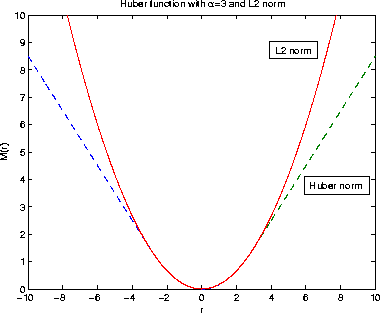A simple choice of robust measure is the ![]() norm: denoting
the residual (misfit) components by
norm: denoting
the residual (misfit) components by ![]() (N being
the number of data points), the
(N being
the number of data points), the ![]() norm misfit function of the residual vector is
norm misfit function of the residual vector is ![]() . This function is not
smooth: it is singular where any residual component vanishes. As a result,
numerical minimization is difficult. Various approaches based for example
on a linear programming viewpoint Barrodale and Roberts (1980) or iterative
smoothing Scales et al. (1988), have been used with
success but require considerable tuning. Moreover, the singularity
implies that small residuals are ``taken as seriously'' as large
residuals, which may not be appropriate in all circumstances.
. This function is not
smooth: it is singular where any residual component vanishes. As a result,
numerical minimization is difficult. Various approaches based for example
on a linear programming viewpoint Barrodale and Roberts (1980) or iterative
smoothing Scales et al. (1988), have been used with
success but require considerable tuning. Moreover, the singularity
implies that small residuals are ``taken as seriously'' as large
residuals, which may not be appropriate in all circumstances.
These drawbacks of the ![]() norm have led to various proposals which
combine robust treatment of large residuals with gaussian
treatment of small residuals. These proposals are known as ``hybrid
norm have led to various proposals which
combine robust treatment of large residuals with gaussian
treatment of small residuals. These proposals are known as ``hybrid
![]() '' methods. For example, Bube and Langan (1997) apply an
iteratively reweighted least-squares (IRLS) method to minimize a hybrid objective
function on a tomography problem. More recently, Zhang et al. (2000) use an
IRLS procedure to locate bed boundaries from electromagnetic
data.
'' methods. For example, Bube and Langan (1997) apply an
iteratively reweighted least-squares (IRLS) method to minimize a hybrid objective
function on a tomography problem. More recently, Zhang et al. (2000) use an
IRLS procedure to locate bed boundaries from electromagnetic
data.
In this chapter, a hybrid ![]() error measure (or norm)
proposed by Huber (1973) is presented:
error measure (or norm)
proposed by Huber (1973) is presented:
| |
(1) |
![[*]](http://sepwww.stanford.edu/latex2html/cross_ref_motif.gif) shows the Huber norm as a function of the residual. It
is smooth near zero residual, weights small residuals by mean square and treats large
residuals with
shows the Huber norm as a function of the residual. It
is smooth near zero residual, weights small residuals by mean square and treats large
residuals with  |
Definition of the misfit via the Huber function
results in a nonlinear optimization problem because any residual
component ri close to the threshold ![]() can oscillate
between the
can oscillate
between the ![]() and
and ![]() norm. In the first section following
this introduction, I propose solving
the optimization problem with a quasi-Newton method called
limited-memory BFGS
Broyden (1969); Fletcher (1970); Goldfarb (1970); Nocedal (1980); Shanno (1970).
In the second section, this method is tested to estimate the root mean
square (rms) velocity (or slowness) of noisy common midpoint (CMP) and
shot gathers
for synthetic and field seismic data. There the Huber norm is compared
with the
norm. In the first section following
this introduction, I propose solving
the optimization problem with a quasi-Newton method called
limited-memory BFGS
Broyden (1969); Fletcher (1970); Goldfarb (1970); Nocedal (1980); Shanno (1970).
In the second section, this method is tested to estimate the root mean
square (rms) velocity (or slowness) of noisy common midpoint (CMP) and
shot gathers
for synthetic and field seismic data. There the Huber norm is compared
with the ![]() norm with and without regularization.
norm with and without regularization.